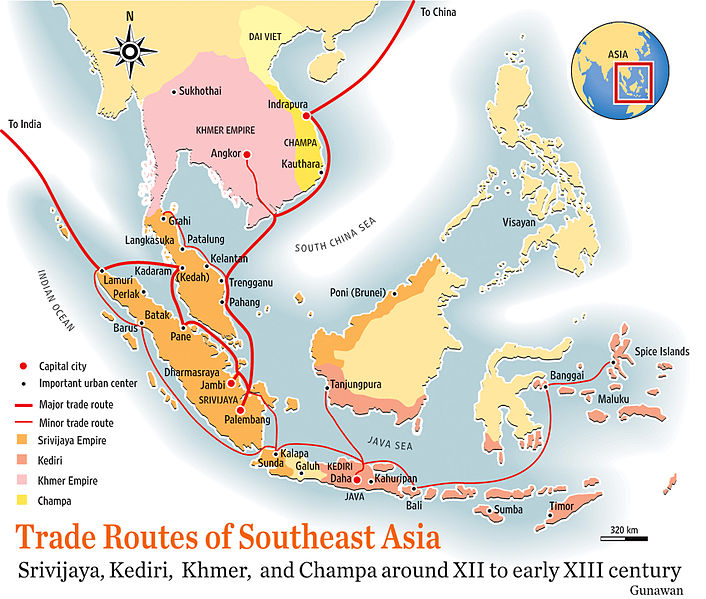Srivijaya Empire Ap World History
Southern asia
South Asia is the region beneath the Hindu Kush mountains and Himalayas. This region, dominated past the modernistic-state of India, claims ane of the world's oldest faiths and a tradition of regional trade.
Resources:
Post-Classical South asia
| Social | The Hindu caste organisation created a hierarchy of power that was both religious and inherited. Hindus, built-in into a degree, typically had to remain in that caste until their death and hopeful reincarnation. This promoted stability, though it too allowed for the stagnation that emerges when at that place is no competition for power. Generally, a woman within the Hindu caste system had more in common with men of her degree than women in other castes. As Islam spread to the region, social roles became more than gendered. |
| Political | Since the autumn of the Mauryan and Gupta Empires, Southern asia has broken into various kingdoms. Various Hindu Rajput Kingdoms emerged in northern India, keeping a centralized power from emerging for hundreds of years. They competed with each other, assuasive for Islamic armies to first to expand into Transitional islamic state of afghanistan and Pakistan. The Delhi Sultanate emerged from this expansion as a powerful kingdom for virtually 300 years. United by Islam and funded by the Silk Road, the Delhi Sultans were able to hold back the Mongol expansion into Southern asia. |
| Cultural | Though still predominantly Hindu, South Asia's development was largely impacted by Buddhism and Islam. Hinduism is a polytheistic religion that is probably best known because of its conventionalities in samsara, or reincarnation. The vast majority of Indians are Hindu. However, unlike many polytheistic faiths, Hinduism is very decentralized. Islam, spreading from the Middle East, is a monotheistic faith that is more cohesive since it blended political leadership with religion. By 1450, Islam has spread to northern India and helped the Delhi Sultanate create a stable regional empire. Southward Asia has seen many globe religions because of positioning on both state and water-based trade routes. |
Southeast Asia
Southeast Asia consists of modernistic nations like Vietnam, Thailand, and Cambodia. This region has developed within a mountainous and jungle environs, making a large empire impossible. The people of Southeast Asia have been heavily influenced past China to the due north and the trade with the west within the Indian Ocean Merchandise Network.

Image Courtesy of Wikimedia
Before the modern-states of Southeast Asia, in that location were diverse empires, both state-based and sea-based, that helped unite the people politically, economically, and religiously.
The Khmer Empire was a powerful state in Southeast Asia, formed by people of the same proper name, lasting from 802 CE to 1431 CE. At its peak, the land-based empire covered much of what today is Cambodia, Thailand, Laos, and southern Vietnam. Its uppercase, Angkor Wat, was originally a Hindu temple, developed over time into a vast Buddhist temple.
The Srivijaya Empire was a Indonesian Hindu empire based on the island of Sumatra, Indonesia, which influenced much of Southeast Asia. Srivijaya was an important center for merchandise between Cathay and India every bit well equally for the expansion of Buddhism from the 8th to the 12th century.
The Majapahit Kingdom was a smaller Javan Buddhist kingdom that controlled the aircraft lane leading to and from the Strait of Malacca.
Southeast Asia benefited economically from the Indian Ocean Trade Network, while information technology also became very diverse. Islamic merchants and Sufi (mystical sect of Sunni Muslims) missionaries brought their faith to Indonesia, making it the most populated Islamic nation in the globe today. This merchandise network and the missionaries traveling with it is ane of the most important factors in the spread of Islam in Southeast Asia.
fundamental questions
- What makes Southeast Asia a singled-out region?
- What were the cardinal factors shaping Southeast Asia
- How did world religions spread in Southeast Asian societies?
- How did Southeast Asian states develop and maintain power?
- How was Southeast Asia a role of "Global Middle Ages?"
Try using a written report timer like the ane in Fiveable rooms to maximize your efficiency when preparing for the test!
Resources:
Srivijaya Empire Ap World History,
Source: https://library.fiveable.me/ap-world/unit-1/south-southeast-asia-1200-1450/study-guide/96NKgXqGcldaDjFAaG4p
Posted by: millermrsawas.blogspot.com


0 Response to "Srivijaya Empire Ap World History"
Post a Comment